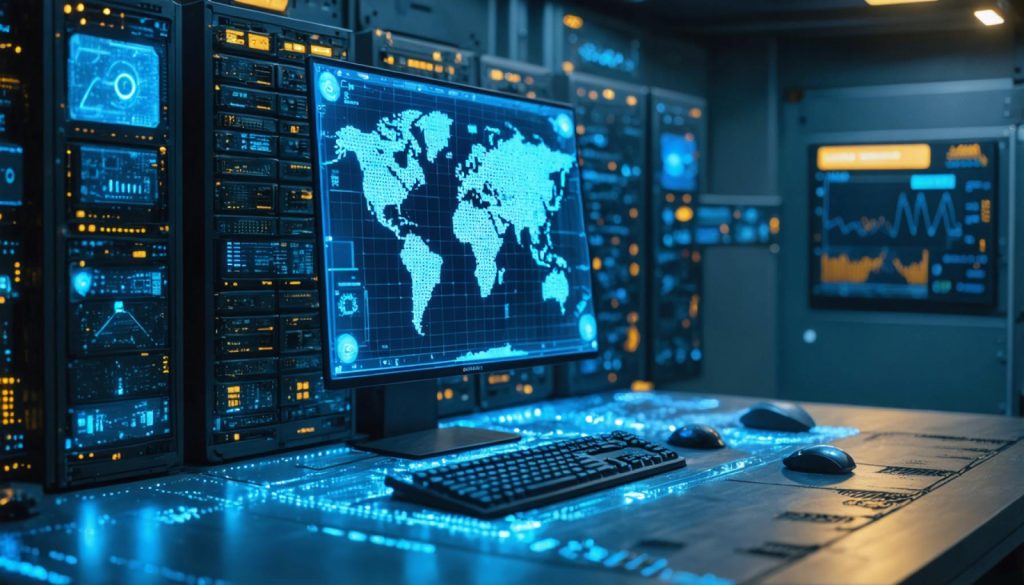
- Kochi, Kerala emerges as a key tech hub with the development of India’s first indigenous AI server, Rudra-3, crafted by VVDN Technologies.
- The server stands as a crucial element in the Param supercomputer series, utilizing eight GPUs to support India’s national AI mission.
- Potential applications of the Rudra-3 span diverse fields, including weather forecasting, disaster management, and medical research.
- VVDN Technologies also unveiled advancements in manufacturing with a new surface mount technology line and mechanical innovation park.
- India’s electronics manufacturing and exports have surged significantly, with manufacturing value increasing fivefold in six years.
- Union Minister Ashwini Vaishnaw highlighted India’s growing talent in designing sophisticated electronic products.
- Kochi’s technological achievements exemplify India’s capability to blend local talent with global innovation goals.
Amidst the serene landscapes and cultural vibrance of Kerala, lies a burgeoning tech hub, quietly but profoundly shaping the future of technology in India. A monumental achievement has emerged from the city of Kochi, marking a significant leap for the nation’s tech landscape. Within the halls of Infopark, a team of visionary engineers at VVDN Technologies has crafted 80% of India’s first fully indigenous artificial intelligence server—an advancement that has captured national attention.
When Union Minister for Electronics and Information Technology, Ashwini Vaishnaw, unveiled this technological marvel at VVDN’s Manesar facility, his pride was palpable. The minister lauded the achievement using the Malayalam word “Adipoli,” resonating with the state’s spirit—a fantastic testament to Kerala’s contribution.
This groundbreaking AI server, known as the Rudra-3, is a formidable component of the Param supercomputer series. It harnesses the power of eight GPUs to bolster India’s national mission on artificial intelligence. Far from a conventional server, the Rudra-3 stands as a beacon of transformation across several sectors. Its potential applications range from enhancing weather forecasting and disaster management, to pioneering research in the realms of thermodynamics and medicine, promising nuanced insights into drug interactions within the human body.
The inauguration also spotlighted VVDN Technologies’ new advancements, including a state-of-the-art surface mount technology line and a mechanical innovation park at their Haryana Global Innovation Park. This event underscores India’s meteoric rise in electronics manufacturing, which has quintupled in the past six years, now exceeding Rs 11 lakh crore in total value. Exports, a vibrant testimony to India’s expanding prowess, have similarly surged sixfold in a decade, surpassing Rs 3.25 lakh crore.
The minister emphasized that India now possesses the talent to not just manufacture but also design sophisticated electronic products, distinguishing itself in the global arena. Kochi’s achievement reflects this narrative—a microcosm of India’s growing capability and innovation.
The riveting story of Kochi’s tech triumph serves a larger purpose: it symbolizes the enchantment of amalgamating local capability with global ambition. As the nation watches the bloom of advanced technology designed on its own soil, a new chapter unfurls, teeming with potential and promising a luminescent horizon for future generations.
Unleashing the Future: How India’s Rudra-3 AI Server Transforms Technology
Understanding the Rudra-3 AI Server: A Deep Dive
The unveiling of the Rudra-3 AI server, a proud achievement for VVDN Technologies in Kerala, marks a pivotal moment in India’s technological journey. This server serves as a crucial component of the Param supercomputer series and represents significant strides in artificial intelligence development. Here, we explore the capabilities and broader implications of this innovation.
Key Features and Specifications
1. GPU Powerhouse: The Rudra-3 is equipped with eight powerful GPUs, engineered to deliver robust computational performance. Such power is essential for extensive AI and data analytics applications.
2. Indigenously Developed: 80% of the server’s components are designed and manufactured in India, showcasing the country’s growing self-reliance in high-tech development.
3. Applications Across Industries:
– Weather Forecasting: Enhanced data processing speeds allow for more accurate and timely predictions, crucial for disaster management.
– Medical Research: Enables breakthroughs in understanding drug interactions, significantly impacting how new medications are developed.
4. Tech Resistance: The server’s design ensures high resistance to electromagnetic interference, enhancing its reliability in various environments.
Market Forecasts and Industry Trends
India’s prowess in electronics design and manufacturing is on a rising trajectory. According to the Union Minister for Electronics and IT, the electronics manufacturing sector has grown fivefold in recent years, now valued at over Rs 11 lakh crore. There is a palpable drive to develop indigenous products that meet global standards, as seen with the Rudra-3.
Industry Impact
– Global Market Entry: With innovations like Rudra-3, India positions itself as a formidable player in the global AI sector.
– Job Creation: The expanding tech hub in Kerala and facilities like VVDN’s Innovation Park create significant employment opportunities in advanced technology.
Real-World Use Cases and Benefits
1. Disaster Management: More sophisticated AI models in servers like Rudra-3 can help improve response times and strategies during natural disasters.
2. Educational Advancements: By offering computational power for research, this technology can boost academic institutions’ capabilities in developing new AI applications.
Security and Sustainability
– Data Security: Emphasizing data privacy, especially with AI processing sensitive information, remains a top priority for developers.
– Eco-friendly Initiatives: The state-of-the-art manufacturing processes at VVDN adhere to international standards of sustainability.
Pros and Cons Overview
Pros
– High Computational Power: Supports complex AI workloads.
– Indigenous Development: Reduces reliance on foreign technology, fostering national growth.
Cons
– Initial Cost: High investment needed for development and integration.
– Infrastructure Needs: Requires advanced infrastructure for optimal performance.
Actionable Recommendations for Readers
– Education and Skills Development: With increasing opportunities in AI, acquiring skills in AI-related fields is advantageous.
– Invest in Local Tech: Support and explore partnerships with local tech firms like VVDN Technologies to boost innovation.
Final Insights
The Rudra-3 AI server represents the potential for home-grown technological advancements to reshape industries globally. As India continues to develop such capabilities, businesses and individuals should leverage these advancements to stay competitive.
For more details on India’s tech advancements, visit Ministry of Electronics and IT.



